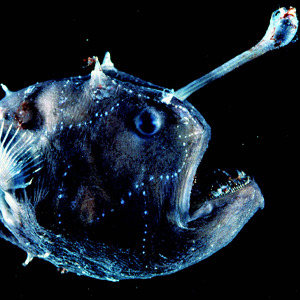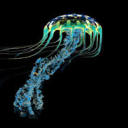Wake Up Babe New Fish Dropped





Wake up babe new fish dropped
More Posts from Bioluminescentoceangoddess and Others

Glasshead Grenadier
Hymenocephalus italicus
The Glasshead Grenadier is a small deep sea fish named due to a transparent memberane that covers its head. It has fragile head bones, and it feeds on surface copepods and crustaceans. This fish is located between 100 m to 2000 m in the ocean.
Photo credit: https://www.fishbase.se/summary/1720
https://www.futura-sciences.com/planete/photos/oceanographie-abysses-ces-merveilles-profondeurs-40-photos-686/ocean-grenadier-vitrier-hymenocephalus-italicus-poisson-abysses-4541/


Pacific Viperfish
Chauliodus macouni
The Pacific Viperfish looks intimidating with its sharp, pointy teeth and large jaws. However, its body is small and elongated. It can be found at depths ranging from 250m to 4390m. The Pacific Viperfish long teeth are an unique adaptation designed to keep prey trapped, but it is dangerously close to its eyes. There have been instances when they have caught prey that are too large to swallow and it dies along with its last meal. The Pacific Viper also has photophores along its body and a light organ near its dorsal fin. These organs exhibit bioluminescence and help with attracting pray: as well as, communicating with mates and confuse predators. It is one of the most ferocious predators of the deep ocean.
Photo credit: https://www.science-rumors.com/top-20-pacific-viperfish-facts-to-know-what-this-creature-is/
https://goldfisho.com/everything-you-need-to-know-about-viperfish/


Pink Helmet
Aglantha digitale
The Pink Helmet is a mini hydromedusa that comes in a variety of vibrant colors. The tiny jelly is only 4 cm in size and is found towards the surface of the ocean. The purple and blue hues we see in its bell are caused by a phenomenon known as iridescence, when light strikes the jelly’s thin tissue at different angles (similar to what we see in a soap bubbles). It also has orange pigmentation near its mouth; this pigmentation helps attract prey and mask luminescence. Furthermore, females tend to be more colorful than males.
Photo credit: https://biolum.eemb.ucsb.edu/organism/pictures/aglantha.html
https://www.pinterest.com/pin/186899453255850798/


Wolftrap Angler
Thaumatichthys binghami
The Wolftrap Angler is slightly different from many other species of anglers. It has its bioluminescent lure located inside of its mouth instead of connected to its body. Even though it is intimidating up close, it is only nine centimeters in size. It is found in the deep ocean at 2432m.
Photo credit
https://en.wikipedia.org/wiki/Thaumatichthys_binghami
https://igniteyourcuriosity.wordpress.com/2016/10/22/anglerfish/


Cigar Comb Jelly
beroe forskalii
The Cigar Comb Jelly is a gelatinous ctenophore that is marveled by many due to its sparkling bioluminescence. It tends to elegantly float around 120 m in the ocean. It uses unique, hair-like structures called ctens to move horizontally in the ocean. It also swims in a spiral pattern before consuming zooplankton in the ocean.
Photo credit: https://www.wrobelphoto.com/gelatinouszooplankton/h25347306
https://www.flickr.com/photos/a_migotto/27227530815


Deep Sea Arrow Worm
Eukrohnia hamata
Arrow worms are small, predatory marine worms that consume copepods, ostracods, and larvae. They resembles a clear, ink pen whizzing through the dark sea. Furthermore, they are found primarily in the Artic Ocean between 700m to 1200m. The picture on the bottom is its head. They have 8 hooks, which are used to grab prey and 25 posterior teeth. Even though the arrow worms are terrifying up close, they are only 4.5 cm in size.
Photo credit: http://www.arcodiv.org/watercolumn/chaetognaths/Eukrohnia_hamata.html

Black- eyed squid
Gonatus onyx
The Black-eyed Squid is roughly over one foot (35 am) and is found at depths as deep as 2500m. The female Black-eyed Squid works fiercely to protect her babies, by carrying around a patch of egg for six to nine months. When the eggs hatch, 2000 to 3000 babies are released into the ocean. However, this makes her vulnerable to predators.
Photocredit: http://tolweb.org/Gonatus+onyx/19769


Physonect Siphonophore
Nanomia cara
The Physonect siphonophore has tiny, bubble shaped sacs that are filled with gas. The sacs are called pneumatophores and help this creature move through the deep ocean. It also has venomous tentacles that stun prey and over eighty stomachs. There are numerous amounts of these strange creatures along the east coast, and they have cause some fisheries to collapse. Furthermore, they can be found at depth between 400m to 1000m.
Photo credit: http://www.seawater.no/fauna/cnidaria/cara.html
https://www.mindenpictures.com/stock-photo-siphonophore-hydrozoan-cnidarian-nanomia-cara-atlantic-nectophores-naturephotography-image90194961.html


Football Fish
Himantolophus paucifilosus
The Football fish is a deep sea angular fish located between 1000 to 4000 meters in the ocean. The glowing dots on its body are sensory organs called neuromast that help the fish detect changes in the water.
Photo credit: https://alchetron.com/Footballfish
https://www.amazon.com/Creatures-Deep-Search-Monsters-World/dp/1770852816


Giant Bell Jelly
Scrippsia pacifica
The Giant Belly Jelly has 256 tentacles attached to a gelatinous bell-shaped base. Like most cnidarians, the Giant Belly Jelly uses specialized stinging cells called nematocysts to catch its prey. When fish and other prey swim into its tentacles, the sensory projection on the cnidocyte (cell that holds the nematocysts) is activated. Then the nematocysts and barb are released, hitting the vulnerable prey and releasing a toxin into the prey’s body. The Giant Bell Jelly is found at 400 m in the ocean. It is related to the jellyfish, but it is categorized as a Hydrozoa (similar to the Portuguese- man-o-war)
https://vimeo.com/42551565
Photo Credit: https://www.pinterest.cl/pin/467107792572034837/
https://courses.lumenlearning.com/ivytech-bio1-1/chapter/phylum-cnidaria/
-
 karul-the-vampire-demon-1099 liked this · 1 week ago
karul-the-vampire-demon-1099 liked this · 1 week ago -
 tardusvenenum liked this · 1 week ago
tardusvenenum liked this · 1 week ago -
 medicinemane reblogged this · 3 weeks ago
medicinemane reblogged this · 3 weeks ago -
 princessofduality reblogged this · 4 weeks ago
princessofduality reblogged this · 4 weeks ago -
 princessofduality reblogged this · 4 weeks ago
princessofduality reblogged this · 4 weeks ago -
 princessofduality liked this · 4 weeks ago
princessofduality liked this · 4 weeks ago -
 a-transboy-in-meadowland reblogged this · 4 weeks ago
a-transboy-in-meadowland reblogged this · 4 weeks ago -
 amxnanodalhard liked this · 1 month ago
amxnanodalhard liked this · 1 month ago -
 wolfgirl255 reblogged this · 1 month ago
wolfgirl255 reblogged this · 1 month ago -
 earthquakening liked this · 1 month ago
earthquakening liked this · 1 month ago -
 splargis liked this · 1 month ago
splargis liked this · 1 month ago -
 purefake liked this · 1 month ago
purefake liked this · 1 month ago -
 moondazie liked this · 1 month ago
moondazie liked this · 1 month ago -
 loveblaster reblogged this · 1 month ago
loveblaster reblogged this · 1 month ago -
 iwannabeacryptidbaybee reblogged this · 1 month ago
iwannabeacryptidbaybee reblogged this · 1 month ago -
 iwannabeacryptidbaybee liked this · 1 month ago
iwannabeacryptidbaybee liked this · 1 month ago -
 gojisaurus liked this · 1 month ago
gojisaurus liked this · 1 month ago -
 tensegold liked this · 1 month ago
tensegold liked this · 1 month ago -
 aylinerik liked this · 1 month ago
aylinerik liked this · 1 month ago -
 bestieari407 liked this · 1 month ago
bestieari407 liked this · 1 month ago -
 crumboat reblogged this · 1 month ago
crumboat reblogged this · 1 month ago -
 crumboat liked this · 1 month ago
crumboat liked this · 1 month ago -
 sharkiiv liked this · 1 month ago
sharkiiv liked this · 1 month ago -
 manic-zombie liked this · 1 month ago
manic-zombie liked this · 1 month ago -
 themangosage reblogged this · 1 month ago
themangosage reblogged this · 1 month ago -
 starparticle liked this · 1 month ago
starparticle liked this · 1 month ago -
 dissonancenoise liked this · 1 month ago
dissonancenoise liked this · 1 month ago -
 t4tmetalsonic reblogged this · 1 month ago
t4tmetalsonic reblogged this · 1 month ago -
 omgkawaiimunchkin liked this · 1 month ago
omgkawaiimunchkin liked this · 1 month ago -
 starrykira reblogged this · 1 month ago
starrykira reblogged this · 1 month ago -
 starrykira liked this · 1 month ago
starrykira liked this · 1 month ago -
 bluebirds-37 liked this · 1 month ago
bluebirds-37 liked this · 1 month ago -
 viviscrolls liked this · 1 month ago
viviscrolls liked this · 1 month ago -
 whatacartouchebag liked this · 1 month ago
whatacartouchebag liked this · 1 month ago -
 totemosvtekirokugatsu6 reblogged this · 1 month ago
totemosvtekirokugatsu6 reblogged this · 1 month ago -
 th3-r4t-48 liked this · 1 month ago
th3-r4t-48 liked this · 1 month ago -
 squeiky reblogged this · 1 month ago
squeiky reblogged this · 1 month ago -
 willowthefoxxo reblogged this · 1 month ago
willowthefoxxo reblogged this · 1 month ago -
 willowthefoxxo liked this · 1 month ago
willowthefoxxo liked this · 1 month ago -
 blackdeathman-2 liked this · 1 month ago
blackdeathman-2 liked this · 1 month ago -
 weirstone reblogged this · 1 month ago
weirstone reblogged this · 1 month ago -
 weirstone liked this · 1 month ago
weirstone liked this · 1 month ago -
 lycansoffspring reblogged this · 1 month ago
lycansoffspring reblogged this · 1 month ago -
 lycansoffspring liked this · 1 month ago
lycansoffspring liked this · 1 month ago -
 unknownhomosapien liked this · 1 month ago
unknownhomosapien liked this · 1 month ago -
 rejectedcopy reblogged this · 1 month ago
rejectedcopy reblogged this · 1 month ago -
 rejectedcopy liked this · 1 month ago
rejectedcopy liked this · 1 month ago -
 fortythreeninetysix liked this · 1 month ago
fortythreeninetysix liked this · 1 month ago

Bioluminescence is a chemical reaction that produces light. Many deep sea animals use bioluminescence. This blog is dedicated to educating the public about the amazing creatures that thrive in the deep sea.
57 posts